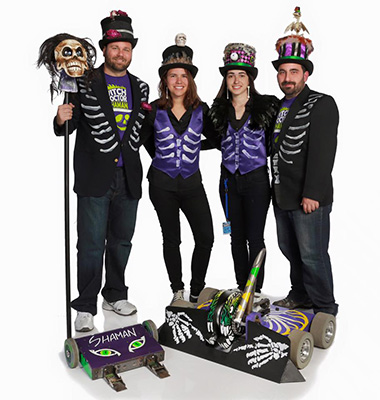Folktales tell us that most witch doctors believe in healing. But this Witch Doctor is bent on maiming, scorching, and annihilating anything in its path.
 |
| Standing over their robots are, from left, Witch Doctor teammates Paul Grata, Jennifer Villa, Andrea Suarez, and Michael Gellatly. |
Designed by a team that includes two University of Miami alumni, Witch Doctor is a 220-pound robot, which, with its flame-throwing sidekick, Shaman, will try to destroy other robotic competitors in the second season of ABC’s BattleBots.
During the course of the season, which premiered June 23, 48 robots will fight in grueling three-minute matches, but only one will ultimately triumph.
Andrea Suarez, B.S., M.S. ’11, and Michael Gellatly, B.S. ’06, are banking on their robotic duo emerging victorious when they compete during the June 30 show.
“Our strategy is a little unusual because we decided to meet the 250-pound weight limit with two robots instead of one,” said Suarez. “Witch Doctor weighs 220 pounds and has a weapon that spins vertically, while Shaman only weighs 30 pounds and uses a large flamethrower to attack its opponents.”
Witch Doctor participated in the first season of BattleBots and made it to the quarterfinals, where it faced the most-feared robot of all: Tombstone.
Although Witch Doctor and his human handlers lost, they inflicted the most damage to Tombstone in season one.
Suarez and Gellatly met when she was in high school at Carrollton School of the Sacred Heart, and he was at UM. At the time, she was competing in high school tournaments with light robots weighing a mere one and two pounds, and he was about to become president of the UM Robotics Team.
When they connected again at UM, they fine-tuned their skills as students in UM’s College of Engineering. Using steel, titanium, and aluminum, they were building electric robots “at a different level,” said Suarez.
“UM gave us the classes and the ability to refine what we knew and then apply it,” she said. “We had resources that we did not have before.”
Working with engineering graduate students and supportive faculty encouraged them to persevere, Gellatly recalls.
“Some people were critical of dueling robots,” said Gellatly. “But we knew that, although we were not saving lives, we were learning valuable engineering lessons.”
The friends continued to compete locally and nationally in college-level robotics competitions, later joining friends Paul Grata and Jennifer Villa to create the Witch Doctor team in 2010. Dressed in top hats and sporting skulls and bones, the team chose its name to appeal to children.
“We wanted to make sure that we drew in kids,” said Suarez. “We wanted children to be attracted to engineering without knowing that they were learning about engineering.”
Their strategy seems to be working. Later this year, the company Hexbug will debut a Witch Doctor toy. And in their day jobs, Suarez and Gellatly are actually enhancing, if not saving, lives. They both work in research and development at Zimmer Biomet, developing implants for traumatic injuries.
